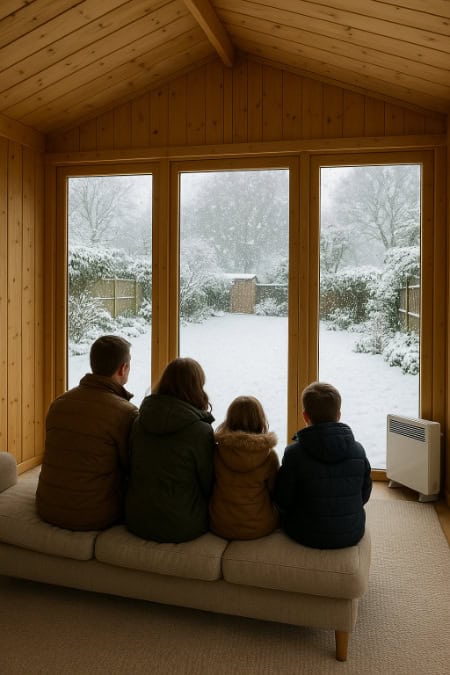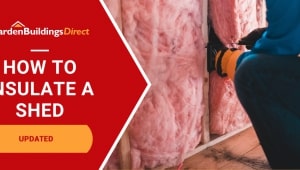Jump to:
You can use a summerhouse in winter, but it won’t be warm on its own. Standard models are often made with thin shiplap or tongue and groove panels which offer little in the way of heat retention. Though they offer weather protection, any heat inside can go straight out through the walls, floor and roof. If you want to spend hours in there, you’ll need to make some changes.
Ways to Enjoy Your Summerhouse in Winter Without Freezing

You can make it work, but it takes a bit of planning. Here’s how:
Use an electric heater
A small plug-in heater can make your summerhouse comfortable for short visits. It won’t keep the whole space warm all day, but it’s enough to sit with a hot drink and enjoy the garden without shivering.
Place it where you’ll be sitting, but out of the way of any draughts. It could be close to the door or tucked into a corner, but make sure it’s on a flat surface and not near anything flammable. Keep the door closed, and you’ll feel the difference right away.
Note: The heat won’t linger long once the heater is off. Energy use will be higher than in a building that can retain heat.
Seal gaps around windows and doors
Even small gaps let cold air find its way in, and that kills any warmth you try to keep inside. The corners, the bottom of the door, and where window frames meet the walls are usually the culprits. Use draught excluders, foam strips, or a rolled-up towel to block any gaps you see in these spots.
Close the door when you’re inside, and the heater will do its job. You can also add a thick curtain over windows to keep heat in and block draughts at the same time. Consider it giving your summerhouse a proper winter coat.
Lay rugs or carpets to reduce floor chill
Cold floors suck heat right out of your feet, and no one wants to spend winter tiptoeing around like a penguin. A rug or carpet adds a layer of insulation and keeps the floor from stealing the warmth from your heater. Even a thin rug works better than bare wood or concrete.
Insulate the summerhouse (if you haven’t already)
Insulation is the real game-changer if you want to use your summerhouse in winter. Boards, rolls, or even foil-backed panels are best for the walls. Floor insulation also stops the chill from creeping up from below. With insulation in place, the heater’s effort doesn’t vanish into thin air.
Most summerhouses don’t come insulated as standard, so it counts as a modification. This may void your warranty, but it’s a worthwhile upgrade if you plan to use it all year round.
Upgrade to a Log Cabin or Insulated Garden Room

Summerhouses are great for relaxing in warmer months. But if you’re after a garden space that works all year, it’s worth looking at a log cabin or an insulated garden room. They’re built with thicker walls and better seals.
Either way, it gives you the same garden escape as a summerhouse but with walls thick enough to keep the cold out. No need for ten layers and a hot water bottle.
Sticking with your current one? No problem! You can pick up more tips here: 5 Best Ways to Enjoy Your Summer House in Winter





